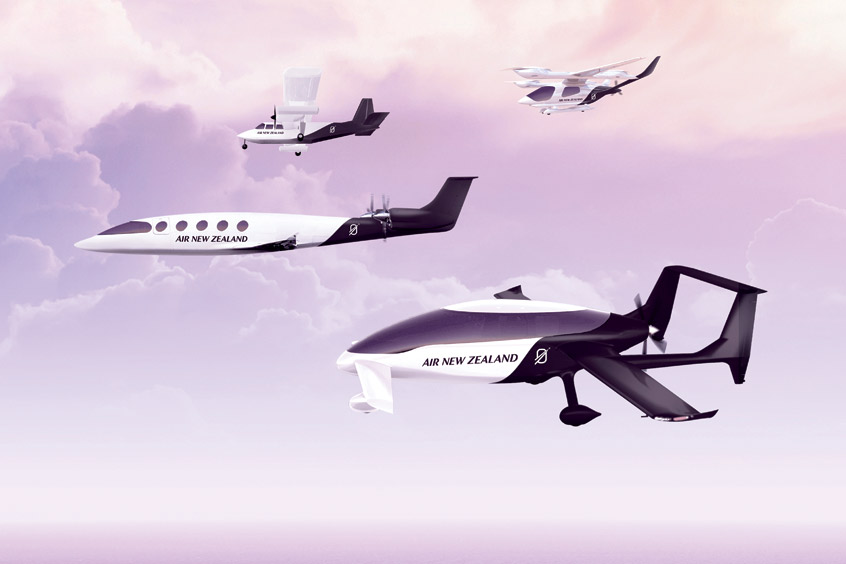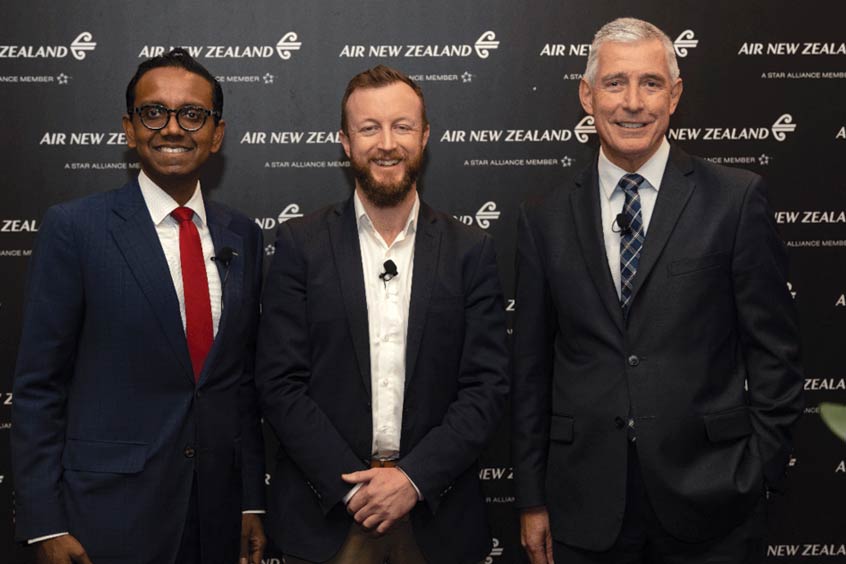ACE 2026 - The home of global charter.
• Beta Technologies
Aircraft
• Cranfield Aerospace Solutions
• Eviation Aircraft Ltd
Aircraft
• VoltAero
Aircraft
• Britten Norman BN-2 Islander
BAN's World Gazetteer
• Vermont The bimonthly news publication for aviation professionals.
The bimonthly news publication for aviation professionals.



Air New Zealand has signed up VoltAero, Eviation, Beta Tech and Cranfield Aerospace to participate on its Mission Next Generation Aircraft programme to have its first zero emissions demonstrator flight, either cargo or passenger, take to the skies from 2026.
A combination of electric, green hydrogen and hybrid aircraft, the partners will work alongside Air New Zealand over coming years to focus on developing the technology and associated infrastructure required to make flying these aircraft in New Zealand a reality. These partnerships involve Air New Zealand signing a statement of intent to order, a document that demonstrates its ambition to acquire three aircraft initially, with further options for 20, from one or more of the partners subject to an evaluation process. The companies were selected by Air NZ based on the stage they are at in their aircraft development journey and their shared goal of starting now to take ambitious action on climate change.
Air NZ CEO Greg Foran says: “Mission NextGen Aircraft is not about backing one horse. It's about working with a range of leaders in zero emissions aircraft technology to help move the whole ecosystem along. Our goal is to confirm our commitment with one or more of these partners in the next 12 months with the ambition of purchasing an aircraft for delivery from 2026.
“The learnings we will take from flying an aircraft with next generation propulsion technology from 2026 will then pave the way for our long-term partners to deliver an aircraft that can replace our Q300 turboprop domestic fleet.
“Getting a zero emissions aircraft off the ground by 2026 is going to be challenging. But we are incredibly ambitious, because we need to be.”
VoltAero’s Cassio electric-hybrid aircraft family provides outstanding safety with a dual source of electric-hybrid energy, along with the ability to utilise runways as short as 1,800 ft, opening the airline's regional airport network infrastructure for its operations.
Additionally, Cassio's hybrid technology offers an optimised cost-of-ownership, minimising the need for heavier battery packs that would reduce flight range, while also avoiding higher cost per kilowatt/hour and diminished battery lifetime.
“Our selection by Air New Zealand is an important confirmation of VoltAero's pragmatic and realistic approach to developing the Cassio aircraft family,” says CEO and chief technical officer Jean Botti. “Instead of promises, we can respond today to Air New Zealand's requirement for the demonstration of next-generation sustainable aircraft.
"Cassio provides outstanding safety and versatility through the propulsion system's dual source of electric-hybrid energy. Additionally, its configurable cabin, along with the propulsion system's adaptability to biofuels and hydrogen for its thermal engine, opens Air New Zealand's regional network to next-generation aircraft that are clean, quiet and efficient.”
VoltAero's proprietary electric-hybrid propulsion system has logged more than 10,000 km since 2019, operating in its full 600 kilowatt power definition aboard the company's Cassio 1 testbed aircraft, performing flights on typical regional airline routes as well as segments over water.
Cassio aircraft will utilise electric motors in the aft fuselage-mounted propulsion system for all-electric power during taxi, take off, primary flight and landing. The hybrid feature (with an internal combustion engine) comes into play as a range extender, recharging the batteries while in flight, and serves as a backup in the event of a problem with the electric propulsion, ensuring true fail-safe functionality. They will be built in three versions with configurations from five to 12 seats, each sharing a high degree of modularity and commonality.
The first production version in process of certification is the five seat Cassio 330 which has a 330 kilowatt propulsion system. Its service entry is targeted for the end of 2024, well ahead of Air New Zealand's objective to purchase new-generation sustainable aircraft for deliveries from 2026.
Eviation's flight-proven, all-electric commuter aircraft Alice is powered by two magni650 electric propulsion units developed by magniX. Built from a clean-sheet design, the aircraft costs significantly less to operate per flight hour compared to light jets or high-end turboprops.
"Regional flights make up a sizeable proportion of Air New Zealand's routes. The Alice offers an effective way to decarbonise these journeys, revolutionising air travel and supporting the goals of the Mission NextGen Aircraft programme," says president and CEO Gregory Davis. "New Zealand has earned a proud reputation for its progressive attitude and wide-ranging policies towards the climate challenge. The Alice is a beautiful aircraft that will delight airline operators and passengers. Seeing it soar through the skies of New Zealand is a magical prospect, and I pay tribute to Air New Zealand's commitment to innovation and sustainability."
"This endorsement from a national flag carrier shows how the Alice has captured the imagination of the marketplace," adds vice president, commercial sales Eddie Jaisaree. "New Zealand has just experienced its warmest, wettest winter on record. As the impacts of climate change become more apparent and efforts to regulate aviation's carbon emissions intensify, we are excited for how the Alice will help Air New Zealand to lead the airline industry into a sustainable future."
CAeS is the only British company selected out of 30 candidates. This sees it move closer to its ultimate goal of reintroducing new aircraft design and manufacture in the UK, putting the UK firmly back on the aerospace map as a manufacturer of whole aircraft as opposed to solely a supplier of structures and components to manufacturers based overseas.
CAeS CEO Paul Hutton adds: “We are extremely proud to have been selected by Air New Zealand as a Mission Next Gen partner. The airline is renowned in the industry for being a powerhouse in sustainability and, given CAeS's ambition to design and manufacture zero emissions green hydrogen fuelled aircraft, our collective ambitions couldn't be more aligned. We look forward to working with the Air New Zealand team to bring zero emissions flight to its domestic network and help pave the way for the next revolution in aviation.”
Its selection follows publication of a report from CAeS and GKN, Rolls-Royce, Heathrow airport and London City airport showing that zero-carbon emission flight is entirely possible from the middle of this decade on sub regional routes on aircraft that range in size from seven to 19 seats. The report also projected that it could be cost-effective to replace the entire UK regional fleet with safe, certified, zero-carbon emission larger aircraft of 50-90 seats by 2040.
Phase 1 of CAeS' roadmap to produce zero-emissions aircraft is Project Fresson, the conversion of a Britten-Norman Islander nine seat aircraft from conventional fossil fuel to that of gaseous hydrogen propulsion. After this, CAeS has a multi-phase programme that includes larger aircraft up to and including 75 or more seat regional aircraft.
UK Aviation Minister Baroness Vere says: “This new partnership is a win for the aviation sectors in the UK and New Zealand, and a win for jet zero flight. Hydrogen offers a potentially game-changing solution for decarbonising aviation, and our two governments will continue working together to make global net zero aviation a reality by 2050.
"Air New Zealand has a long history of embracing innovation and taking action toward change, and the world needs global thought leaders like this to make a meaningful difference in the climate crisis right now," said Beta CEO and founder Kyle Clark. "Air New Zealand is stepping up, and we will be right here with it to make it a reality.”
To further understand the infrastructure required to fly green-hydrogen aircraft, Air NZ has also signed a strategic alliance agreement with green-hydrogen supply and refuelling infrastructure company Hiringa Energy.
"While the aircraft play a pivotal role, infrastructure partners are just as important. Through this agreement we will explore the future green hydrogen supply solutions for our commercial demonstrator ambitions with a focus on ensuring any solutions we create to meet our 2026 goal are also building a platform for a larger next generation fleet from the 2030s,” says Foran.
While zero emissions aircraft technology will help decarbonise the airline's domestic network over the period to 2050, SAF is important in the near term for the long-haul fleet. SAF is a 'drop in' fuel that can power current aircraft, so it can reduce emissions for long haul travel and domestic flights while the airline continues to operate conventional aircraft. The inputs and processes used to make SAF result in lower lifecycle emissions than fossil jet, with the opportunity to generate significant CO2 savings.
Hiringa Energy chief executive Andrew Clennett says the agreement is key to accelerating the development of hydrogen as a sustainable and renewable zero emission fuel for both the airline and New Zealand: "Kiwis will be excited Air New Zealand is taking a lead in identifying zero emissions aircraft and backing local companies like Hiringa Energy to help overcome the challenges of providing green hydrogen to power them.”